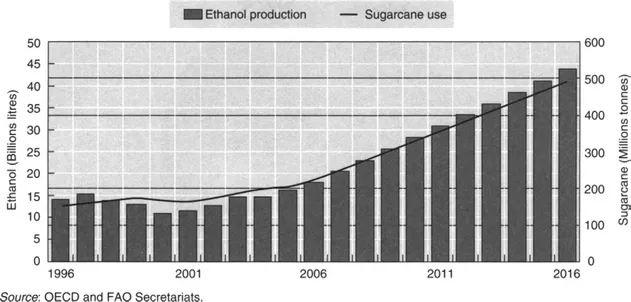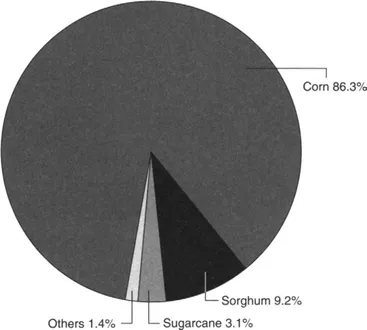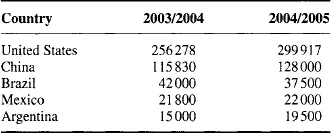
eBook - ePub
The Triazine Herbicides
Janis Mc Farland Ph.D., Orvin Burnside Ph.D., Janis Mc Farland, Ph.D., Orvin Burnside, Ph.D.
This is a test
Buch teilen
- 600 Seiten
- English
- ePUB (handyfreundlich)
- Über iOS und Android verfügbar
eBook - ePub
The Triazine Herbicides
Janis Mc Farland Ph.D., Orvin Burnside Ph.D., Janis Mc Farland, Ph.D., Orvin Burnside, Ph.D.
Angaben zum Buch
Buchvorschau
Inhaltsverzeichnis
Quellenangaben
Über dieses Buch
Over the past 50 years, triazines have made a great impact on agriculture and world hunger by assisting in the development of new farming methods, providing greater farming and land use capabilities, and increasing crop yields. Triazines are registered in over 80 countries and save billions of dollars a year. The Triazine Herbicides is the one book that presents a comprehensive view of the total science and agriculture of these chemicals. With emphasis on how the chemicals are studied and developed, reviewed, and used at the agricultural level this book provides valuable insight into the benefits of triazine herbicides for sustainable agriculture.
- Presents previously unpublished information on the discovery, development and marketing of herbicides
- Includes a vital section on the origin, use, economics and fate of triazine herbicides
- Covers benefits of triazines in corn and sorghum, sugarcane, citrus, fruit and nut crops
- Establishes best management practice and environmental benefits of use in conservation tillage
Häufig gestellte Fragen
Wie kann ich mein Abo kündigen?
Gehe einfach zum Kontobereich in den Einstellungen und klicke auf „Abo kündigen“ – ganz einfach. Nachdem du gekündigt hast, bleibt deine Mitgliedschaft für den verbleibenden Abozeitraum, den du bereits bezahlt hast, aktiv. Mehr Informationen hier.
(Wie) Kann ich Bücher herunterladen?
Derzeit stehen all unsere auf Mobilgeräte reagierenden ePub-Bücher zum Download über die App zur Verfügung. Die meisten unserer PDFs stehen ebenfalls zum Download bereit; wir arbeiten daran, auch die übrigen PDFs zum Download anzubieten, bei denen dies aktuell noch nicht möglich ist. Weitere Informationen hier.
Welcher Unterschied besteht bei den Preisen zwischen den Aboplänen?
Mit beiden Aboplänen erhältst du vollen Zugang zur Bibliothek und allen Funktionen von Perlego. Die einzigen Unterschiede bestehen im Preis und dem Abozeitraum: Mit dem Jahresabo sparst du auf 12 Monate gerechnet im Vergleich zum Monatsabo rund 30 %.
Was ist Perlego?
Wir sind ein Online-Abodienst für Lehrbücher, bei dem du für weniger als den Preis eines einzelnen Buches pro Monat Zugang zu einer ganzen Online-Bibliothek erhältst. Mit über 1 Million Büchern zu über 1.000 verschiedenen Themen haben wir bestimmt alles, was du brauchst! Weitere Informationen hier.
Unterstützt Perlego Text-zu-Sprache?
Achte auf das Symbol zum Vorlesen in deinem nächsten Buch, um zu sehen, ob du es dir auch anhören kannst. Bei diesem Tool wird dir Text laut vorgelesen, wobei der Text beim Vorlesen auch grafisch hervorgehoben wird. Du kannst das Vorlesen jederzeit anhalten, beschleunigen und verlangsamen. Weitere Informationen hier.
Ist The Triazine Herbicides als Online-PDF/ePub verfügbar?
Ja, du hast Zugang zu The Triazine Herbicides von Janis Mc Farland Ph.D., Orvin Burnside Ph.D., Janis Mc Farland, Ph.D., Orvin Burnside, Ph.D. im PDF- und/oder ePub-Format sowie zu anderen beliebten Büchern aus Technology & Engineering & Agronomy. Aus unserem Katalog stehen dir über 1 Million Bücher zur Verfügung.
Information
Thema
AgronomyChapter 1
The Triazine Herbicides: A Milestone in the Development of Weed Control Technology
Homer M. LeBaron, Heber, Utah
Janis E. McFarland, Syngenta Crop Protection, Inc., Greensboro, North Carolina
Orvin C. Burnside, University of Minnesota, Minneapolis, Minnesota
Summary
This book is about the revolutionary impact of the triazines herbicides, likely the most important class of agricultural chemicals ever developed. For five decades the triazines have provided weed control in more than 50 crops around the world and have helped farmers boost yields and produce enough food to feed a rising global population. The triazine herbicides, and especially atrazine, are the most well-researched herbicides in history, with thousands of scientific studies on their safety to humans and the environment. Data from studies on the triazines have been evaluated extensively by regulatory authorities around the globe to ensure their safe use.
The first triazine was discovered in 1952 at J.R. Geigy, Ltd. in Switzerland and led to major advances in agricultural practices, basic research, safety testing, and environmental stewardship. Today one or more of the triazine herbicides is registered in more than 100 countries around the globe to provide broad-spectrum weed control in a variety of crops and noncrop sites. They provide application flexibility, are extensively used in conservation tillage programs that are integral to sustainable agriculture, and are important contributors to the management of weed biotypes that have developed resistance to other classes of herbicides.
The triazine herbicides are essential for high-yield, sustainable agriculture. They are critical to integrated pest management (IPM) and conservation tillage practices in corn and other crops – reducing the devastating environmental impact of erosion, reducing fuel costs, and retaining moisture in soil.
Changes in Agriculture and the Importance of the Triazine Herbicides
Since the 1900s, there have been significant improvements in agriculture yields, with average increases ranging from 238% to 811% for corn, cotton, sorghum, soybean, wheat, potato, and tomato (Table 1.1). From an average corn yield of 2.76 metric tonnes/ha during 1950–1959, yields of 8.87 metric tonnes/ha were obtained during 2000–2004. Since the late 1950s, the triazine herbicides have contributed significantly to improvements in yields in crops around the world.
Table 1.1
US average yield in metric tonnes/ha and percent change for 10-year periods through 1999 and for the 5-year period of 2000 through 2004a

aThis table has been modified and updated from Warren (1998) as averages from USDA National Agricultural Statistics Service data.
bThe numbers in parentheses are percentages of increases or decreases based on the average yields of the crops in the first decade given.
The historical record reveals that herbicides have replaced or reduced the use of hand weeding and cultivation for weed control, with an associated reduction in cost and an increase in yield. Today herbicides are used routinely on more than 90% of the area of most US crops, representing 87 million ha of cropland (Gianessi and Reigner, 2007).
There is a need for continued increases in yields not only to feed a growing world population, but also for greater fuel production (OECD-FAO, 2007). For example, US ethanol production, predominately based on corn, is expected to double between 2006 and 2016 (Figure 1.1). By 2016, ethanol is expected to represent a full one-third of corn production. Corn used for fuel in China is expected to increase from 3.5 million tons in 2006 to 9 million tons in 2016 (Figure 1.2). Ethanol production in Brazil is predominately based on sugarcane and is expected to increase by 145% between 2006 and 2016 (Figure 1.3).

Figure 1.1 Expansion of US ethanol production and corresponding use of corn (maize). (figure from OECD-FAO)

Figure 1.2 Expansion of Chinese ethanol production and corresponding use of corn (maize). (figure from OECD-FAO)

Figure 1.3 Expansion of Brazil ethanol production and corresponding use of sugarcane. (figure from OECD-FAO)
The first triazine was discovered in 1952 at J.R. Geigy, Ltd. in Switzerland. Today one or more of the triazine herbicides are registered in more than 100 countries around the world and are key to the production of more than 50 crops. Table 1.2 shows the major triazine herbicides today and their key uses.
Table 1.2
Major triazine herbicides and a partial listing of key uses
| Triazine herbicide | Uses |
| Ametryn | Sugarcane, corn, pineapple |
| Atrazine | Corn, sorghum, sugarcane |
| Hexazinone | Alfalfa, sugarcane, forestry, noncropland |
| Metamitron | Sugarbeet, other beet crops |
| Metribuzin | Sugarcane, potato, soybean |
| Prometon | Noncropland |
| Prometryn | Cotton, celery |
| Simazine | Corn, citrus, grape, apple, almond, walnut, peach, filbert, pear |
| Terbuthylazine | Corn, sorghum, grape |
| Terbutryn | Sugarcane, cereal |
The use volumes in the United States by major crops are shown in Figure 1.4 for atrazine and Figure 1.5 for simazine.

Figure 1.4 Average atrazine use by crop in the United States for 2000–2002 (Doane Marketing Research, Inc.).

Figure 1.5 Average simazine use by crop in the United States for 2000–2002 (Doane Marketing Research, Inc.).
Atrazine is by far the mostly widely used of the triazines, and corn is its major crop use. Table 1.3 shows the top five corn-producing countries in the world. Atrazine is a critical component in the herbicide programs of each of these countries.
Table 1.3
Major corn production countries in the world (thousands of metric tonnes) a

aUS Department of Agriculture (USDA) Foreign Agricultural Service (2005).
One of the reasons the triazines are so important in corn and other crops around the world is their application flexibility and their ability to mix with other herbicides for broad-spectrum weed control. Figure 1.6...